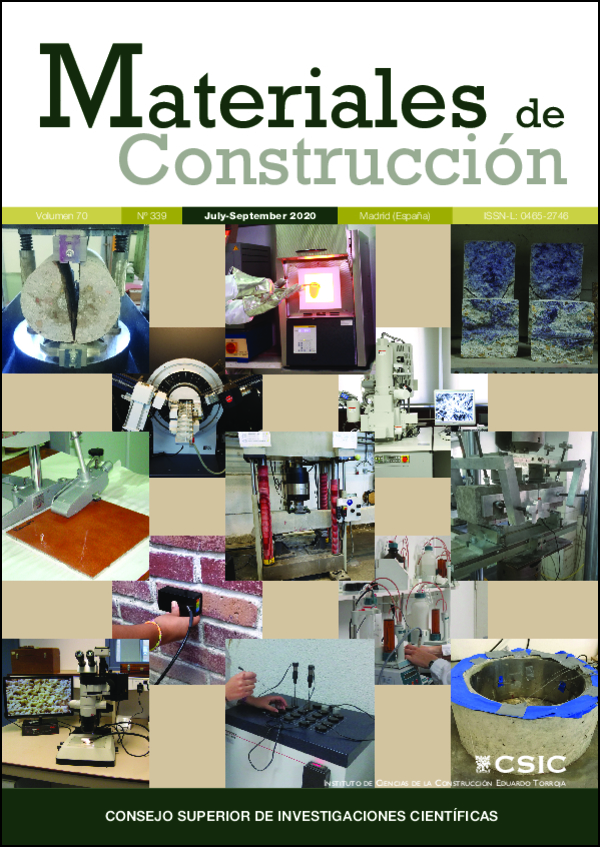Análisis microestructural de hormigones fabricados con áridos gruesos reciclados premojados según diferentes métodos
DOI:
https://doi.org/10.3989/mc.2020.16919Palabras clave:
Hormigón, Zona interfacial, Tratamiento de residuos, Microestructura, Análisis de imágenesResumen
El hormigón reciclado tiene una microestructura más compleja que el natural, ya que incluye nuevas zonas de transición interfacial, cuya calidad está condicionada por el estado de humedad de los áridos utilizados, lo que a su vez repercutirá en las propiedades finales del hormigón. Teniendo en cuenta la mayor capacidad de absorción de los áridos reciclados, se considera fundamental la mejora de sus propiedades, mediante un método de tratamiento que sea capaz de disminuir los efectos negativos que éstos puedan producir en el hormigón. Por ello, se analiza la influencia del método de premojado de los áridos reciclados en la formación de la microestructura de hormigones fabricados con estos áridos, para así determinar qué tratamiento es el más eficaz. Los resultados muestran que la microestructura de los hormigones evaluados difiere según el método de tratamiento utilizado, siendo el más óptimo el que utiliza los áridos sin premojar.
Descargas
Citas
Comisión Europea (2014) COM 445. Comunicación de la comisión al Parlamento Europeo, al Consejo, al Comité Económico y Social Europeo y al Comité de las Regiones. Oportunidades para un uso más eficiente de los recursos en el sector de la construcción. Comisión Europea, Bruselas, (2014).
Comisión Europea (2015) COM 614. Comunicación de la Comisión al Parlamento Europeo, al Consejo, al Comité Económico y Social Europeo y al Comité de las Regiones. Cerrar el círculo: Un plan de acción de la UE para la economía circular (COM 614). Comisión Europea, Bruselas, (2014).
UEPG (2017) European aggregates association. A sustainable industry for a sustainable Europe. Annual Review 2016-2017. Union Européenne des Producteurs de Granulats. Retreived from http://www.uepg.eu/uploads/Modules/Publications/uepg-ar2016-17_32pages_v10_18122017_pbp_small.PDF.
Tam, V.W.Y.; Soomro, M.; Evangelista, A.C.J. (2018) A review of recycled aggregate in concrete applications (2000-2017). Constr. Build. Mater. 172, 272-292. https://doi.org/10.1016/j.conbuildmat.2018.03.240
Ministerio de Fomento (2008) EHE-08. Instrucción de Hormigón Estructual. BOE. 203, 35176-35178.
Poon, C.-S.; Shui, Z.; Lam, L.; Fok, H.; Kou, S.-C. (2004) Influence of moisture states of natural and recycled aggregates on the slump and compressive strength of concrete. Cem. Concr. Res. 34 [1], 31-36. https://doi.org/10.1016/S0008-8846(03)00186-8
Etxeberria, M.; Vázquez-Ramonich, E.; Marí, A.R.; Barra de Oliveira, M. (2007) Influence of amount of recycled coarse aggregates and production process on properties of recycled aggregate concrete. Cem. Concr. Res. 37 [5], 735-742. https://doi.org/10.1016/j.cemconres.2007.02.002
Thomas García, C.; Setién, J.; Polanco Madrazo, J.A.; Cimentada, A.I.; Medina, C. (2018) Influence of curing conditions on recycled aggregate concrete. Constr. Build. Mater. 172, 618-625. https://doi.org/10.1016/j.conbuildmat.2018.04.009
Etxeberria, M. (2004) Experimental study on microstructure and structural behaviour of recycled aggregate concrete. Univ. Politec. Catalunya. 242. http://hdl.handle.net/2117/93470.
Li, W.; Xiao, J.; Sun, Z.; Kawashima, S.; Shah, S.P. (2012) Interfacial transition zones in recycled aggregate concrete with different mixing approaches. Constr. Build. Mater. 35, 1045-1055. https://doi.org/10.1016/j.conbuildmat.2012.06.022
Puertas Maroto, F.; Blanco Varela, M.T.; Palomo Sánchez, Á. (1989) Microestructura del hormigón: influencia sobre sus propiedades. Monografia no 398, Consejo Superior de Investigaciones Científicas.
Maso, J.C. (1996) Interfacial Transition Zone in Concrete: state-of-the-art report. RILEM Techical Comm. 108-ICC, Interfaces Cem. Compos. 179. https://doi.org/10.1201/9781482271560 PMCid:PMC1380637
Gao, X.F.; Lo, Y.T.; Tam, C.M. (2002) Investigation of micro-cracks and microstructure of high performance lightweight aggregate concrete. Build. Environ. 37 [5], 485-489. https://doi.org/10.1016/S0360-1323(01)00051-8
Etxeberria, M.; Vázquez-Ramonich, E.; Marí, A.R. (2006) Microstructure analysis of hardened recycled aggregate concrete. Mag. Concr. Res. 58 [10], 683-690. https://doi.org/10.1680/macr.2006.58.10.683
Bonifazi, G.; Capobianco, G.; Serranti, S.; Eggimann, M.; Wagner, E.; Di Maio, F.; Lotfi, S. (2015) The ITZ in concrete with natural and recycled aggregates: Study of microstructures based on image and SEM analysis. In: Proc. 15th Euroseminar Microsc. Appl. to Build. Mater.
-308. Retreived from http://resolver.tudelft.nl/uuid:b92471c4-2a8e-4643-9c59-0bca35957025.
Xiao, J.; Li, W.; Corr, D.J.; Shah, S.P. (2013) Effects of interfacial transition zones on the stress-strain behavior of modeled recycled aggregate concrete. Cem. Concr. Res. 52, 82-99. https://doi.org/10.1016/j.cemconres.2013.05.004
Duan, P.; Shui, Z.; Chen, W.; Shen, C. (2013) Enhancing microstructure and durability of concrete from ground granulated blast furnace slag and metakaolin as cement replacement materials. J. Mater. Res. Technol. 2 [1], 52-59. https://doi.org/10.1016/j.jmrt.2013.03.010
Tam, V.W.Y.; Tam, C.M. (2007) Assessment of durability of recycled aggregate concrete produced by two-stage mixing approach. J. Mater. Sci. 42, 3592-3602. https://doi.org/10.1007/s10853-006-0379-y
Wang, R.; Yu, N.; Li, Y. (2020) Methods for improving the microstructure of recycled concrete aggregate: A review. Constr. Build. Mater. 242, 118164. https://doi.org/10.1016/j.conbuildmat.2020.118164
Pelufo, M.J.; Domingo Cabo, A.; Ulloa Mayorga, V.A.; Vergara Acuña, N.N. (2009) Analysis of moisture state of recycled coarse aggregate and its influence on compression strength of the concrete. Shell Spat. Struct. IASS. [October], 2932-2940. http://hdl.handle.net/10251/6652.
Mefteh, H.; Kebaïli, O.; Oucief, H.; Berredjem, L.; Arabi, N. (2013) Influence of moisture conditioning of recycled aggregates on the properties of fresh and hardened concrete. J. Clean. Prod. 54, 282-288. https://doi.org/10.1016/j.jclepro.2013.05.009
Sánchez-Roldán, Z.; Martín-Morales, M.; Valverde-Palacios, I.; Valverde-Espinosa, I.; Zamorano, M. (2016) Study of potential advantages of pre-soaking on the properties of pre-cast concrete made with recycled coarse aggregate. Mater. Constr. 66 [321], e076. https://doi.org/10.3989/mc.2016.01715
Tam, V.W.Y.; Gao, X.F.; Tam, C.M. (2005) Microstructural analysis of recycled aggregate concrete produced from twostage mixing approach. Cem. Concr. Res. 35 [6], 1195-1203. https://doi.org/10.1016/j.cemconres.2004.10.025
Leite, M.B.; Monteiro, P.J.M. (2016) Microstructural analysis of recycled concrete using X-ray microtomography. Cem. Concr. Res. 81, 38-48. https://doi.org/10.1016/j.cemconres.2015.11.010
Thomas García, C.; Setién, J.; Polanco, J.A.; de Brito, J.; Fiol, F. (2019) Micro- and macro-porosity of dry- and saturated-state recycled aggregate concrete. J. Clean. Prod. 211, 932-940. https://doi.org/10.1016/j.jclepro.2018.11.243
Zhang, W.; Wang, S.; Zhao, P.; Lu, L.; Cheng, X. (2019) Effect of the optimized triple mixing method on the ITZ microstructure and performance of recycled aggregate concrete. Constr. Build. Mater. 203, 601-607. https://doi.org/10.1016/j.conbuildmat.2019.01.071
Sidorova, A.; Vázquez-Ramonich, E.; Barra-Bizinotto, M.; Roa-Rovira, J.J.; Jimenez-Pique, E. (2014) Study of the recycled aggregates nature's influence on the aggregate-cement paste interface and ITZ. Constr. Build. Mater. 68, 677-684. https://doi.org/10.1016/j.conbuildmat.2014.06.076
Aligizaki, K.K. (2006) Pore structure of cement-based materials: testing, interpretation and requirements, Taylor & Francis, Abingdon, England, (2006). https://doi.org/10.1201/9781482271959
Bravo, M.; Santos Silva, A.; de Brito, J.; Evangelista, L. (2016) Microstructure of Concrete with Aggregates from Construction and Demolition Waste Recycling Plants. Microsc. Microanal. 22 [1], 149-167. https://doi.org/10.1017/S1431927615015512 PMid:26700727
Bonifazi, G.; Palmieri, R.; Serranti, S. (2018) Evaluation of attached mortar on recycled concrete aggregates by hyperspectral imaging. Constr. Build. Mater. 169, 835-842. https://doi.org/10.1016/j.conbuildmat.2018.03.048
Estefano De Oliveira, M.J.; Barros Oliveira, M.C.; Silveira de Assis, C.; Tavares de Mattos, J. (2004) Petrographic Analysis on Recycled Aggregate-produced Concrete. In: Int RILEM Conf Use Recycl. Mater. Build. Struct. 563-570.
Molina, E.; Cultrone, G.; Sebastián, E.; Alonso, F.J.; Carrizo, L.; Gisbert, J.; Buj, O. (2011) The pore system of sedimentary rocks as a key factor in the durability of building materials. Eng. Geol. 118 [3-4], 110-121. https://doi.org/10.1016/j.enggeo.2011.01.008
Molina, E.; Cultrone, G.; Sebastián, E.; Alonso, F.J. (2013) Evaluation of stone durability using a combination of ultrasound, mechanical and accelerated aging tests. J. Geophys. Eng. 10 [3], 035003. https://doi.org/10.1088/1742-2132/10/3/035003
Abbas, A.; Fathifazl, G.; Fournier, B.; Isgor, O.B.; Zavadil, R.; Razaqpur, A.G.; Foo, S. (2009) Quantification of the residual mortar content in recycled concrete aggregates by https://doi.org/10.1016/j.matchar.2009.01.010
image analysis. Mater. Charact. 60 [7], 716-728.
AEN/CTN 146 (2009) EN 12620:2003+A1. Aggregate for concrete. Áridos para hormigón. AENOR, Madrid. Retreived from https://www.aenor.com/normas-y-libros/buscador-denormas/une?c=N0043155.
Agrela, F.; Sánchez de Juan, M.; Ayuso, J.; Geraldes, V.L.; Jiménez, J.R. (2011) Limiting properties in the characterisation of mixed recycled aggregates for use in the manufacture of concrete. Constr. Build. Mater. 25 [10], 3950-3955. https://doi.org/10.1016/j.conbuildmat.2011.04.027
Cachim, P.B. (2009) Mechanical properties of brick aggregate concrete. Constr. Build. Mater. 23 [3], 1292-1297. https://doi.org/10.1016/j.conbuildmat.2008.07.023
Mas, B.; Cladera, A.; Olmo, T. Del; Pitarch, F. (2012) Influence of the amount of mixed recycled aggregates on the properties of concrete for non-structural use. Constr. Build. Mater. 27 [1], 612-622. https://doi.org/10.1016/j.conbuildmat.2011.06.073
Evangelista, L.; De Brito, J. (2007) Mechanical behaviour of concrete made with fine recycled concrete aggregates. Cem. Concr. Compos. 29 [5], 397-401. https://doi.org/10.1016/j.cemconcomp.2006.12.004
Bear, J.; Bachmat, Y. (1990) Introduction to modeling of transport phenomena in porous media, Kluwer Academic Publishers, Dordrecht, Netherlands (1990), Theory Appl. Transp. Porous Media. Retreived from https://www.springer.com/gp/book/9780792305576. https://doi.org/10.1007/978-94-009-1926-6_2
Thomas, J.; Thaickavil, N.N.; Wilson, P.M. (2018) Strength and durability of concrete containing recycled concrete aggregates. J. Build. Eng. 19, 349-365. https://doi.org/10.1016/j.jobe.2018.05.007
Huang, B.; Shu, X.; Li, G. (2005) Laboratory investigation of portland cement concrete containing recycled asphalt pavements. Cem. Concr. Res. 35 [10], 2008-2013. https://doi.org/10.1016/j.cemconres.2005.05.002
López Orozco, J.O. (2004) Porosidad del concreto. (Tesina). Universidad de San Carlos, Guatemala. Recuperado de http://biblioteca.usac.edu.gt/tesis/08/08_2394_C.pdf.
Valcuende, M.; Marco, E.; Parra, C.; Serna, P. (2012) Influence of limestone filler and viscosity-modifying admixture on the shrinkage of self-compacting concrete. Cem. Concr. Res. 42 [4], 583-592. https://doi.org/10.1016/j.cemconres.2012.01.001
Chen, X.; Wang, G.; Dong, Q.; Zhao, X.; Wang, Y. (2020) Microscopic characterizations of pervious concrete using recycled Steel Slag Aggregate. J. Clean. Prod. 254, 120149. https://doi.org/10.1016/j.jclepro.2020.120149
Nagataki, S.; Gokce, A.; Saeki, T.; Hisada, M. (2004) Assessment of recycling process induced damage sensitivity of recycled concrete aggregates. Cem. Concr. Res. 34 [6], 965-971. https://doi.org/10.1016/j.cemconres.2003.11.008
Lee, G.C.; Choi, H.B. (2013) Study on interfacial transition zone properties of recycled aggregate by micro-hardness test. Constr. Build. Mater. 40, 455-460. https://doi.org/10.1016/j.conbuildmat.2012.09.114
Zheng, C.; Lou, C.; Du, G.; Li, X.; Liu, Z.; Li, L. (2018) Mechanical properties of recycled concrete with demolished waste concrete aggregate and clay brick aggregate. Results Phys. 9, 1317-1322. https://doi.org/10.1016/j.rinp.2018.04.061
Bustillo Revuelta, M. (2010) Manual de RCD y áridos reciclados, Fueyo editores, Madrid, (2010).
Sidorova, A. (2013) Estudio del efecto de la naturaleza del árido reciclado en la microestructura y propiedades de la zona de transición árido-pasta de cemento. Universitat Politècnica de Catalunya. Retreived from http://hdl.handle.net/10803/129569.
Al-bayati, H.K.A.; Tighe, S.L.; Baaj, H. (2016) Effect of Different Treatment Methods on the Interfacial Transition Zone Microstructure to Coarse Recycled Concrete Aggregate. In: Green Technol. Geotechical Mater. Eng. Session, 2016 Conference of the Transportation Association of Canada Toronto. Retreived from https://www.tac-atc.ca/sites/default/files/conf_papers/al-bayati_.pdf.
Lo, Y.; Gao, X.F.; Jeary, A.P. (1999) Microstructure of pre-wetted aggregate on lightweight concrete. Build. Environ. 34 [6], 759-764. https://doi.org/10.1016/S0360-1323(98)00060-2
Publicado
Cómo citar
Número
Sección
Licencia
Derechos de autor 2020 Consejo Superior de Investigaciones Científicas (CSIC)

Esta obra está bajo una licencia internacional Creative Commons Atribución 4.0.
© CSIC. Los originales publicados en las ediciones impresa y electrónica de esta Revista son propiedad del Consejo Superior de Investigaciones Científicas, siendo necesario citar la procedencia en cualquier reproducción parcial o total.
Salvo indicación contraria, todos los contenidos de la edición electrónica se distribuyen bajo una licencia de uso y distribución “Creative Commons Reconocimiento 4.0 Internacional ” (CC BY 4.0). Consulte la versión informativa y el texto legal de la licencia. Esta circunstancia ha de hacerse constar expresamente de esta forma cuando sea necesario.
No se autoriza el depósito en repositorios, páginas web personales o similares de cualquier otra versión distinta a la publicada por el editor.
















